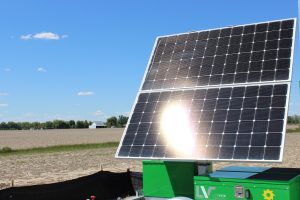A sprawling solar array in Highland County now powers 20% of Cincinnati’s operations and tens of thousands of homes.
Cincinnati’s 900-acre solar farm was completed in May. Director of Environment and Sustainability Ollie Kroner says the first six months of full operations have gone smoothly.
“For the most part, maintenance has been minimal,” Kroner said. “We went out to tour the site earlier this year and they highlighted that the main maintenance is mowing the lawn in between the arrays. They did learn that sometimes mowing the lawn throws a pebble and that can crack a module. So, there’s been replacement here or there of minor components.”Kroner says the solar array was built oversized, so even if some of the panels are not functioning, the array is still able to generate enough power to meet the city’s needs.
RELATED: A new butterfly park in New Richmond is about rebirth in more ways than oneIt produces 100 megawatts of electricity annually: 35 megawatts for city operations like powering rec centers and water treatment, and 65 megawatts for residential use through the Energy Aggregation Program.
Kroner says the solar array has saved the city both money and climate-changing greenhouse gas emissions.
“March of 2024 to August of 2024, it has saved approximately 77,000 tons of carbon dioxide — that’s without the additional 65 megawatts that powers the aggregation program,” Kroner said. “So, pretty significant proportional savings on carbon.”The carbon dioxide emissions avoided by the solar array in five months is equivalent to the emissions produced by burning 84,859,901 pounds of coal, according to the Environmental Protection Agency’s Greenhouse Gas Equivalencies Calculator.
“Big picture, this has been one of the most significant carbon reduction efforts the city’s undertaken,” Kroner said. “It really makes it a no-brainer and makes us very interested in replicating this model again and again moving forward.”While Cincinnati leaders have supported the renewable energy project since former Mayor John Cranley announced it in 2019, some Highland County residents were hesitant about the construction of a massive solar array nearby.
During a 2021 discussion with WVXU, Highland County residents said they worried about problems the solar farm would bring, like the loss of nature and farmland, and the buzz of solar panels.
WVXU reached out to the Highland County Commissioners (who approved the solar project and heard people speak for and against it during meetings) to ask how their constituents were feeling now that the array has been completed, but did not hear back by the deadline for this report.
Progress toward renewable energy goals
Cincinnati has a goal of transitioning to 100% renewable energy by 2035. The solar array gets the city 20% closer.
RELATED: Chamber report highlights benefits of attracting, keeping Gen Z workers in the regionKroner says the city’s demand for electricity is increasing as it transitions more operations to use renewable energy.
“We’re moving away from natural gas and gasoline in instances where we can, and electrifying both transportation and buildings, and with that means an uptick in the amount of electricity we need,” Kroner said. “It’s a bit of a moving target. As our electricity demand increases, as our pursuit of 100% renewable energy catches up.”Kroner says the city is considering more solar energy projects to close the gap in the next 11 years. It has a request for proposals out now.






